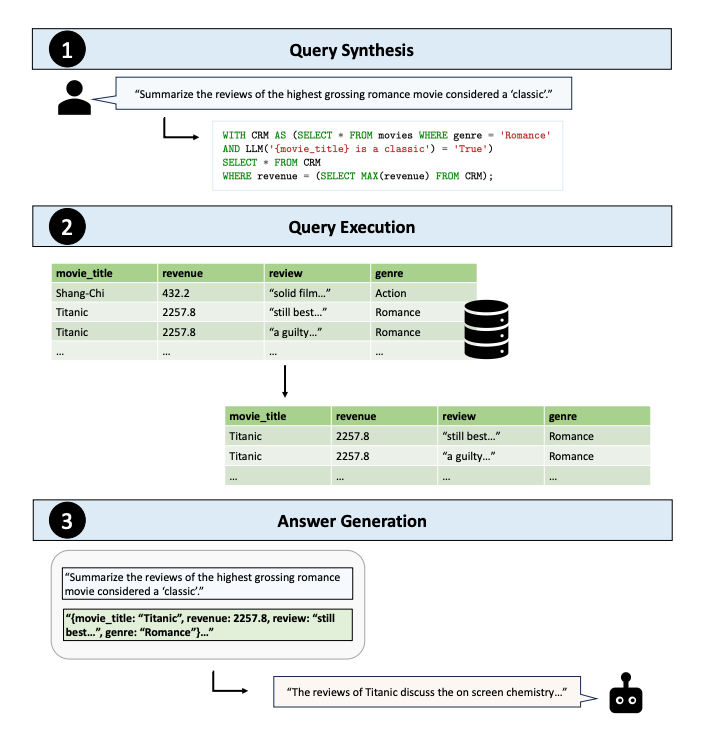Why Text2SQL Falls Short: How TAG is Revolutionizing AI-Powered Database Queries
Unlocking deeper insights with a blend of AI reasoning and traditional data management systems
In today's data-driven world, the idea of querying databases with natural language is fascinating. Imagine being able to ask any question in plain English and instantly getting the right answer, no SQL queries or technical skills needed. This is where technologies like Text2SQL come into play, aiming to translate natural language into database queries. But as incredible as that sounds, it’s not quite enough for the complex questions businesses face daily. Enter Table-Augmented Generation (TAG), a new approach designed to tackle this challenge by combining the strengths of AI and traditional database systems.
What is Text2SQL?
Text2SQL is a system that translates natural language questions into SQL queries. It works pretty well for simple database queries, especially those that have direct relational equivalents like "What is the total sales for Q1?". It does a great job handling these types of questions. However, real-world questions often go beyond what SQL can express. Users don’t just want numbers—they want insights, patterns, or explanations that involve reasoning, world knowledge, and sometimes, complex data relationships.
The Problem with Current Methods
While Text2SQL is a step forward, it has limitations. It can only answer questions that fit neatly into SQL queries. For instance, let’s say you want to know, “Why did my sales drop in the last quarter?” or “What are customers saying about product X in their reviews?”. These are not simple lookups. They require a deeper understanding of the data, the ability to analyze trends, and sometimes even perform sentiment analysis. Text2SQL falls short in these scenarios because it doesn’t have the capability to reason over unstructured data or connect external world knowledge.
Similarly, another approach called Retrieval-Augmented Generation (RAG) tries to address this by retrieving a few relevant pieces of information and using AI to generate answers. But RAG is also limited to small, simple queries that can be solved with basic lookups.
Enter TAG: A New Paradigm
TAG, or Table-Augmented Generation, is a more flexible and powerful way of answering natural language questions over databases. It works in three steps:
Query Synthesis: TAG first takes the natural language question and creates an executable query based on the database schema.
Query Execution: It then runs this query to retrieve the relevant data from the database.
Answer Generation: Finally, TAG uses the retrieved data along with AI to generate a coherent and useful answer in natural language.
Unlike Text2SQL or RAG, TAG can handle much more complex queries. It can incorporate reasoning, context, and even external knowledge not explicitly stored in the database. This allows it to answer a broader range of questions with higher accuracy.

Why TAG is Better
What makes TAG stand out is its ability to combine the raw computational power of databases with the reasoning abilities of AI. Databases are great at handling large-scale, structured data and performing exact computations like aggregations or filtering. On the other hand, AI models excel at semantic reasoning—understanding meaning from unstructured data like text, images, or external world knowledge.
For example, if you ask, "Which customer reviews of product X are positive?", TAG can retrieve the reviews from the database and use AI to determine whether each review is positive or negative. Similarly, if you ask, "What are the trends in retail for the last quarter?", TAG can combine data from the database with external knowledge about the retail sector to give a more nuanced answer.
The Road Ahead
The research on TAG is still developing, but early results are promising. TAG systems outperform current methods in both accuracy and execution time, especially for complex queries. While common approaches like Text2SQL might correctly answer 20% of queries, TAG-based systems are hitting success rates as high as 65%. This significant improvement highlights the potential of TAG to transform how we interact with data.
By unifying AI and database capabilities, TAG offers an exciting way forward for businesses and users who need more than just simple database lookups. Whether you're analyzing customer feedback, tracking sales performance, or exploring complex datasets, TAG brings us one step closer to the dream of truly intelligent, natural language interfaces for data.

